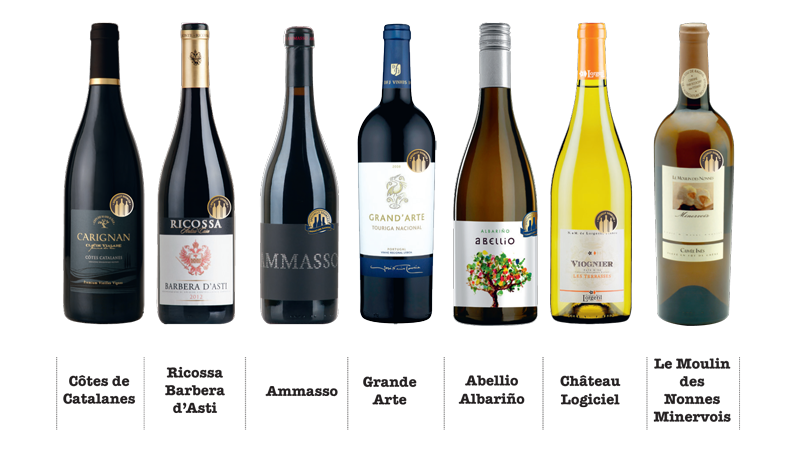The Next Big Thing
Over the last year I find myself increasingly commenting on how Irish consumers are expanding their repertoire of wine to include little-known brands and lesser-known grapes. At SuperValu we have become more adventurous too. I want to give our customers something different, yet balanced with sensibility. Big brands will always be relevant and will always have their place. They always deliver and are always reliable. The problem with being reliable, though, is that wineries looking to target global markets will aim for safe ground and will do so via the biggest-selling grapes by volume: white wines from Sauvignon Blanc, Pinot Grigio and Chardonnay and red wines from Merlot, Cabernet Sauvignon and Shiraz. There’s nothing wrong with that, but if you want to expand your knowledge, then have some fun with other varieties.
Start by looking at the grape on the label or by looking at alternative countries. Portugal is famous for port but also produces some fantastic wines from indigenous grapes, like reds from Touriga Nacional and whites from Arinto or Alvarinho. A Portuguese wine will almost always deliver something new and their reds are some of the best-value wines on the shelf.
"Lesser-known grapes deliver brilliant value"
So what are the grapes or wines that are making waves? Albariño, Carignan, Carménère, Mourvèdre, Negroamaro, Nero d’Avola, Picpoul, Roussanne, Teroldego, Viognier … the list goes on. Most, if not all, are unfamiliar names yet they all sell well.
Many have been drunk for years, hidden behind what is deemed to be the more important call-out: the appellation or demarcation for the wine region. For example, Mourvèdre is one of the main grapes of the famed Châteauneuf-du- Pape along with the slightly better known Grenache (called Garnacha in Spain, but that’s for another day). And if you have ever drunk an Italian Gavi, then you’ve also been drinking the grape Cortese. Who knew?
Grape varieties from other famed regions are now finding new homes elsewhere. Albariño, from Spain’s Rías Baixas region, will soon be on our shelves from New Zealand alongside Gewürztraminer from Chile. For me, value doesn’t mean the cheapest bottle on display. This is why lesser-known grapes deliver such brilliant value, as they haven’t reached the global heights of other wines. In the right hands, these grapes have the diversity and ability to produce brilliant wines. This means more adventurous wine drinkers can find some real gems at a price that appeals, in wines that will surprise. Isn’t that the fun of buying wine? So look to expand and follow our suggestions and I promise your enjoyment of wine will improve tenfold. You’re bound to come across a few that won’t agree with you, as do I, but don’t let that stop you. Here are some of my favourite value busters, with one criteria in mind: I want quality wines that challenge and surprise me and that deliver more than what I paid for.
Whites
Albariño (AL-bar-EE-nyoh)
The body is usually light and delicate, especially from Portugal, where it’s called Alvarinho, but those from Galicia in Spain can be more medium bodied. While acidity is high, it’s best enjoyed when it's young and fresh and is an excellent match for seafood. Albariño has greatly increased in popularity in recent years and deservedly so, but production is very limited outside of Europe, with some also coming from New Zealand.
Viognier (vee-oh-NYAY)
Famous for the wines of northern Rhône, Viognier requires old vines to be at its best so quality will improve over time. Having said that, there are many excellent varietal examples made to deliver a fresh, vibrant style with stone fruit character like apricot and peach. If you haven’t tried Viognier yet, seek out a good-quality example. You’re in for a treat!
Roussanne (roo-SAHN)
The wines Roussanne makes are rich and complex with oral aromas and flavours of peaches, pears, honey and nuts with mineral notes. In the northern Rhône they can be quite delicate on their own, requiring some Marsanne to add structure. In warmer climates they are generally full bodied, and as acidity is naturally high they have considerable ageing potential. Although availability is limited, you can find some excellent examples from the warmer regions of southern France.
Reds
Carignan (kar-in-YON)
A grape that historically has been used in blending has recently been finding new ground as a standalone due to modern techniques but also via the use of older vines. Older vines produce less fruit, but that same fruit has added concentration. While you can expect to pay more, you can easily pick up a bottle for €10 or less. Think of violets and herbs, with the older vines producing spice with a smooth cherry note finish.
Barbera (bar-BER-ah)
This grape from the region of Piedmont in northern Italy makes a fruit-forward style of wine. Mouth-watering lushness and a soft texture with flavours of red berries and plums make it a brilliant wine to pair with tomato-based foods from lasagne to pizza.
Nero d’Avola (NEH-ro DA-voe-lah)
The most important variety in Sicily, this grape is seeing growing interest internationally as it adapts so well to hot climates. Using the appassimento process to raisin the grape, it produces incredible concentration of lush black cherry fruits with leather and spice and a real mouth- filling wine.
Touriga Nacional (too-REE-gahna-son-AL)
A native wine of Portugal, many believe it’s best in a blend but it’s increasingly fashionable to make it as a 100% pure varietal wine. At its best it’s a lush yet vibrant wine with great character and finesse. It ages well and can need a few years to soften its tannic structure, but as it does its rich flavours deepen and develop wonderfully.
7 Wines to try


